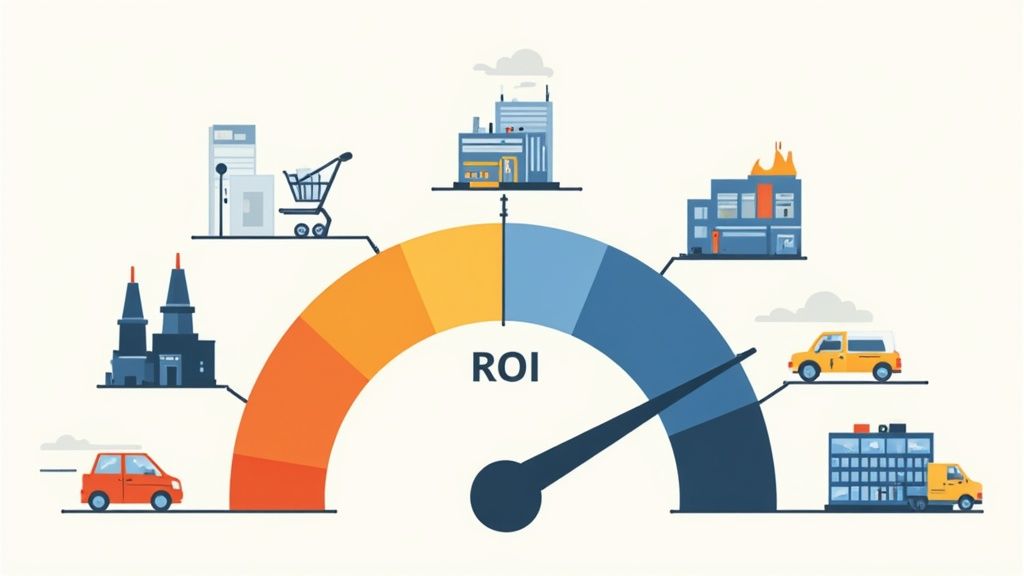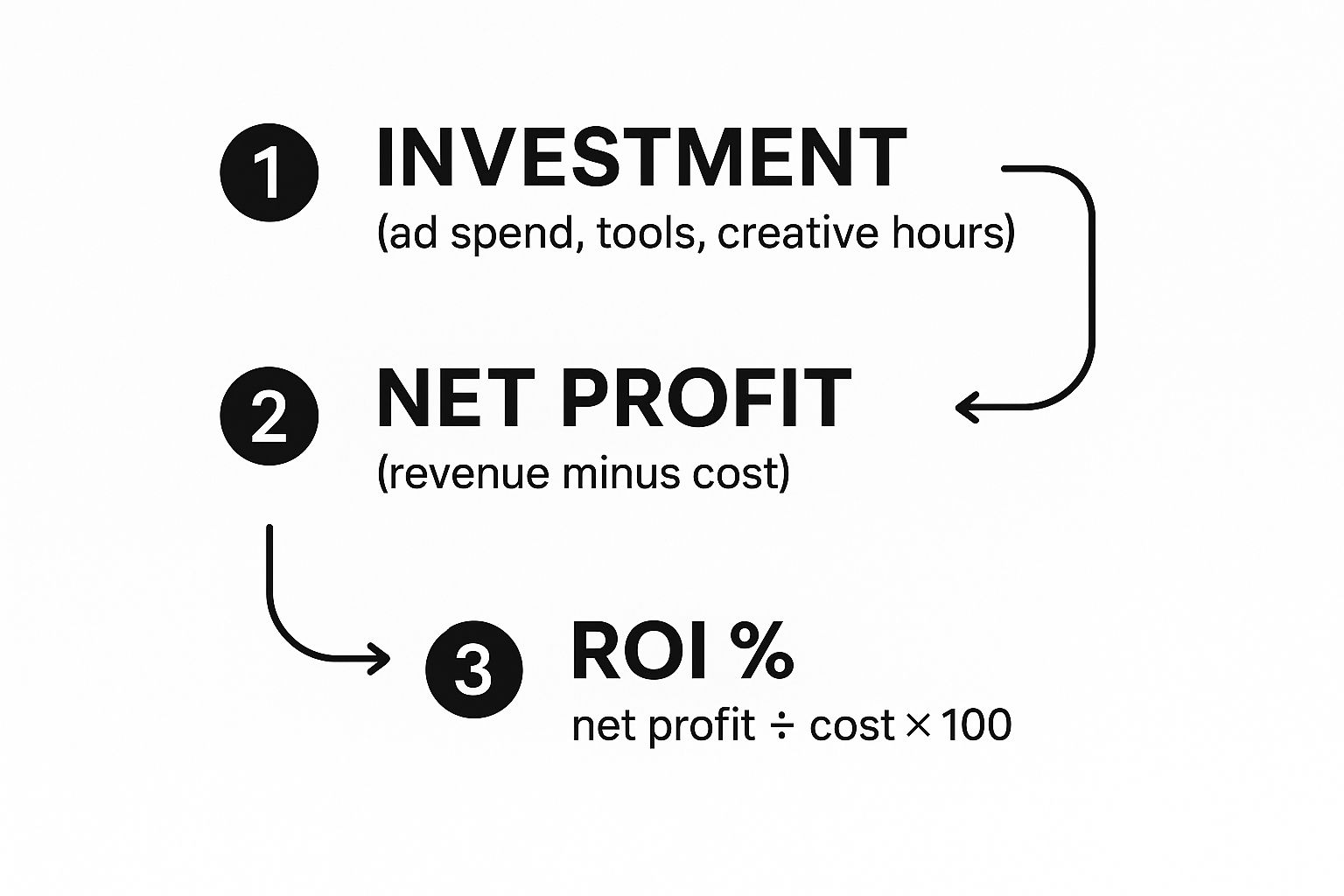How to Measure Marketing ROI Like a Pro
At its core, the marketing ROI formula is pretty straightforward. You take the revenue generated from your marketing, subtract what you spent on it, and then divide that number by your total marketing cost.
It’s usually shown as a percentage, and it’s the clearest way to see the direct financial return on your spending. This is the number that’s crucial for justifying budgets and figuring out where to go next.
Why Marketing ROI Is More Than Just a Number

Knowing the formula is one thing, but truly understanding marketing ROI means seeing it as more than just a performance metric. Think of it as a strategic tool. It's what translates all your hard work—the clicks, the leads, the engagement—into the language the C-suite speaks: revenue, profit, and growth.
When you can confidently draw a line from your marketing activities straight to the bottom line, the entire conversation changes. Your team stops being viewed as a cost center and starts being recognized as a vital revenue driver. This shift in perspective is what unlocks bigger budgets, builds trust with leadership, and proves your work is aligned with the company's biggest goals.
To make sure we're all on the same page, let's quickly break down the key terms you'll see throughout this guide.
Key Marketing ROI Terminology at a Glance
This table is your quick reference for the core concepts we’ll be diving into.
| Term | Definition | Why It Matters |
|---|---|---|
| Marketing Investment (Cost) | The total amount of money spent on marketing activities, including ad spend, salaries, and tool subscriptions. | This is the "I" in ROI. You can't calculate a return without knowing exactly what you put in. |
| Return (Revenue) | The total revenue generated that can be directly or indirectly attributed to marketing efforts. | This is the outcome you're measuring. Accurately attributing revenue is the biggest challenge and the most important part. |
| Customer Lifetime Value (CLV) | A prediction of the net profit attributed to the entire future relationship with a customer. | CLV helps you justify higher initial acquisition costs by looking at the long-term value, not just the first sale. |
| Cost Per Acquisition (CPA) | The total cost of acquiring one new customer from a specific campaign or channel. | This metric tells you how efficient your campaigns are. A high CPA can quickly eat into your ROI. |
| Attribution Modeling | The practice of assigning credit for sales and conversions to different touchpoints in the customer journey. | Attribution helps you understand which channels are actually driving results, preventing you from cutting a channel that's working. |
Understanding these terms is the foundation for having a meaningful conversation about performance and strategy.
Beyond the Basic Calculation
Thinking about how to measure marketing ROI forces you to look deeper than just surface-level metrics. You have to take a holistic view of your entire marketing ecosystem. What’s considered a "good" ROI can be wildly different from one industry to another, or even between two campaigns for the same company.
For example, a high-margin SaaS business might be shooting for a 10:1 return to be happy, while a lower-margin e-commerce store could be thrilled with a 3:1 ratio. Context is everything. Understanding this nuance keeps you from making common mistakes, like chasing a channel that brings in tons of cheap leads that never actually buy anything.
Still, making that direct connection between a marketing activity and a final sale remains a huge challenge. A recent report found that 41% of marketers struggle to measure ROI across their different channels. This usually comes down to the messy reality of the modern customer journey, where a single purchase can be influenced by a dozen different touchpoints over weeks or months. You can find more details on these industry hurdles in the marketing data report for 2025.
The Strategic Value of ROI Insights
At the end of the day, calculating ROI isn't about getting a single number to put in a report. It's about generating actionable insights that shape your entire strategy.
It helps you answer the tough questions:
- Which channels are actually profitable, not just busy?
- Where should we put the next dollar in our budget for the biggest impact?
- How do we prove the long-term value of things like brand awareness and content marketing?
By consistently measuring and analyzing ROI, you move from making decisions based on gut feelings to making them based on cold, hard data. This data-driven approach empowers you to optimize underperforming campaigns, double down on what works, and build a more resilient and effective marketing machine.
Mastering the Core Marketing ROI Formulas
Okay, let's move from theory to practice. This is where you really start to see what's working and what's not. The good news? You don't need a math degree to calculate marketing ROI. It all starts with one simple, powerful formula that will be the foundation for all your analysis.
The most basic formula for marketing ROI is:
(Net Profit / Marketing Cost) x 100 = ROI %
This calculation spits out a clean percentage, showing you exactly how much profit you earned back for every dollar you spent. If you get a result of 200%, for example, that means you generated $2 in net profit for every single $1 invested. Simple as that.
For a deeper dive into these fundamentals, you might want to check out this definitive guide on how to measure marketing ROI.
This infographic really simplifies the three-step flow of figuring out your return on investment.

As you can see, it's a logical path: figure out what you spent, calculate the profit you made, and then use those two numbers to get your final ROI percentage.
Applying the Formula to Real-World Scenarios
The basic formula is a great starting point, but its real power comes alive when you adapt it to different marketing situations. Let's walk through a couple of common examples.
Example 1: A PPC Lead Generation Campaign
Imagine you’re running a Google Ads campaign to drum up leads for your B2B software.
- Investment: You spend $5,000 on ad clicks and another $1,000 on a landing page tool. Your total cost is $6,000.
- Return: The campaign brings in 50 qualified leads. Looking at your past data, you know each lead is worth about $500 in eventual revenue. That gives you a total lead value of $25,000.
- Net Profit: $25,000 (Return) - $6,000 (Investment) = $19,000
- Calculation: ($19,000 / $6,000) x 100 = 316.7% ROI
This tells you the campaign was a huge success, generating over three times its cost in pure value.
Key Takeaway: The biggest mistake marketers make is using revenue instead of net profit. Always subtract your costs from the revenue generated to get an accurate picture. Gross revenue inflates your ROI and can lead to poor budget decisions.
Expanding the Definition of Return
Not every marketing "return" is an immediate sale. For something like content marketing, the return might be a long-term asset like customer loyalty or stronger brand authority. In these cases, we often have to look at Customer Lifetime Value (CLV).
Example 2: An E-commerce Flash Sale
Let's say an e-commerce brand runs a 48-hour flash sale promoted with email blasts and social media ads.
- Investment: The whole campaign costs $10,000, which includes ad spend and the time for your designer and copywriter.
- Return: The sale pulls in $40,000 in direct revenue.
- Net Profit: $40,000 (Revenue) - $10,000 (Investment) = $30,000
- Calculation: ($30,000 / $10,000) x 100 = 300% ROI
That’s a solid return on its own. But what if that campaign also brought in 200 brand-new customers who are likely to shop again? The true ROI is actually much higher. For more on this, check out our guide on improving customer lifetime value to see how you can factor these long-term gains into your calculations.
Choosing the Right Metrics for Each Channel

Not all marketing channels are created equal, and if you try to measure them with the same yardstick, you’ll end up with confusing, inaccurate data. This is one of the biggest mistakes I see people make.
The key is to match your metrics to the channel's specific strengths and the actual goals of your campaign. Trying to measure a brand awareness campaign on Instagram with the same direct-response KPIs you use for email is a recipe for disaster.
To get a true picture of your marketing ROI, you have to tailor your key performance indicators (KPIs) to the unique nature of each platform. This ensures you're judging performance based on what the channel is actually designed to do, giving you a much clearer view of what's driving results.
High-Return Channels Like Email Marketing
Email marketing consistently delivers some of the highest returns out there. With an estimated 4.37 billion users worldwide in 2023, its reach is simply massive. It’s a powerhouse, offering an average ROI of $36 to $40 for every $1 spent—a staggering return of over 3600%.
There's a reason why 80% of marketers would rather give up social media than email. It just works. For more stats that drive this point home, you can check out this deep dive into digital marketing statistics.
Because email is such a direct line to your audience, the metrics for calculating its ROI are refreshingly straightforward.
- Conversion Rate: This is your bread and butter. It's the percentage of people who clicked a link in your email and completed a desired action, like making a purchase. It’s the clearest indicator of your email’s effectiveness.
- Revenue Per Email (RPE): Simply divide the total revenue from a campaign by the number of emails delivered. This gives you a hard dollar value for every single message you send.
- List Growth Rate: While not a direct revenue metric, a healthy, growing list is a fantastic leading indicator of future ROI potential. A stagnant list is a warning sign.
By zeroing in on these specific metrics, you can draw a straight line from your email efforts to your bottom line, making it one of the easiest channels to justify from an ROI perspective.
Measuring the Impact of Social Media
Social media is a completely different beast. Sure, it can drive direct sales, but its real value often lies in brand building, community engagement, and filling the top of your funnel. A common mistake is getting fixated on vanity metrics like likes and followers, which tell you next to nothing about financial return.
To effectively measure social media ROI, you have to connect the dots between engagement and tangible business outcomes.
- Lead Generation: Track how many qualified leads you get from social media forms, gated content, or the link in your bio. You can then assign a value to each lead based on your historical sales data.
- In-App or On-Site Conversions: This is where tracking pixels and UTM parameters become your best friends. Use them to monitor how many users click through from a social post and actually make a purchase or complete another valuable action on your website.
- Assisted Conversions: Dig into your analytics. Look at how many times social media was a touchpoint in a customer journey that eventually led to a sale, even if it wasn't the final click. This shows its influence in the bigger picture.
The goal is to move beyond surface-level engagement and trace the path from a social interaction to a profitable action. This requires a more nuanced, data-driven approach. Adopting one of these data-driven marketing strategies can help you build the right framework.
Making Sense of Advanced Attribution Models and Tools

The modern customer journey is anything but a straight line. It's a messy, winding road. A buyer might see a LinkedIn ad, read a blog post a week later, click an email link, and finally convert after seeing a retargeting ad on Instagram.
If you only give credit to that final ad, you're missing the whole story. This is exactly why getting your head around attribution models is so critical for measuring marketing ROI with any real accuracy.
Attribution is just the framework you use to decide which touchpoints get credit for a conversion. Sticking with a simplistic model is a surefire way to misread your data and pour money down the drain. For instance, if you only credit the last touchpoint, you might slash the budget for top-of-funnel activities that were essential for introducing that customer to your brand in the first place.
Common Attribution Models Explained
The right model for you really depends on your sales cycle and what you're trying to achieve. Each one tells a slightly different story about how customers find you.
Here’s a quick rundown of the most common types:
- First-Touch Attribution: This one’s simple. It gives 100% of the credit to the very first interaction a customer has. It’s great for figuring out which channels are your best brand awareness drivers.
- Last-Touch Attribution: The polar opposite. All credit goes to the final touchpoint before conversion. It's the easiest to track and tells you what’s closing deals, but it completely ignores the entire journey that led up to it.
- Linear Attribution: This model spreads the love equally across every single touchpoint. It’s a more balanced view that acknowledges every interaction played a part, but it lacks nuance.
- Data-Driven Attribution: This is the smartest of the bunch. It uses machine learning to analyze your past conversion data and assign credit based on the actual impact of each interaction. It’s the most accurate by far, but it requires a ton of data and usually lives inside advanced analytics platforms.
The model you choose will completely change how your ROI numbers look. A last-touch model might make your Google Ads look like a superstar, while a linear model could reveal that your humble blog content was just as influential over the long haul.
Going Beyond Standard Attribution
For businesses with long, complex sales cycles or a ton of marketing channels, even the standard multi-touch models can fall short. That’s when you need to bring in the heavy hitters.
Marketing Mix Modeling (MMM) is a top-down, statistical approach. Instead of tracking individual user journeys, it looks at historical data on a macro level. It analyzes how different variables—like marketing spend, seasonality, economic trends, and even what your competitors are doing—impact sales. This is especially powerful for measuring the ROI of channels that are notoriously hard to track, like TV ads or PR campaigns.
Another powerful technique is incrementality testing. This is all about running controlled experiments (think A/B tests on steroids) to measure the true "lift" a campaign provides. By comparing a test group that sees your marketing to a control group that doesn't, you can isolate the real causal impact of your efforts. It answers the ultimate question: is your ad spend genuinely driving new business, or is it just taking credit for sales that would have happened anyway?
The tools you use can make or break your ability to track these complex interactions. While Google Analytics is a fantastic free starting point, you'll likely need more specialized platforms as you scale. For early-stage companies trying to piece together an effective tech stack, our guide on essential startup marketing tools can help you find the right solutions without breaking the bank.
How to Tell Your ROI Story to Leadership
You’ve done the hard work of calculating your marketing ROI, which is a huge win. But here’s the thing—the numbers alone won’t get you that budget increase. The real magic happens when you can turn that data into a story that actually lands with the C-suite.
Executives don’t just want to see a percentage. They want to understand the why behind the numbers and, most importantly, how your team’s efforts are directly pushing the company’s biggest needles: revenue, profit, and sustainable growth.
Framing your results is everything. Stop leading with a laundry list of marketing acronyms like CTR or CPL. You have to start the conversation with business outcomes. That one simple shift turns a talk about costs into a conversation about value.
Speak the Language of Business
Your leadership team lives and breathes high-level business goals. To make your ROI report hit home, you need to draw a straight line from your marketing performance to the metrics that keep them up at night. It's all about translating your wins into their language.
Here’s a quick guide to reframing common marketing metrics so they resonate with an executive audience:
-
Instead of: "Our MQLs increased by 40%."
-
Try: "We drove a 40% increase in marketing-qualified leads, which directly filled the sales pipeline with $250,000 in new opportunities this quarter."
-
Instead of: "Our email campaign had a 300% ROI."
-
Try: "Our targeted email campaign generated $3 in net profit for every $1 we invested, proving it's one of our most efficient revenue drivers."
This approach immediately shows the tangible business value of your work. It makes it much easier for leadership to see marketing as a core revenue function rather than just another cost center.
Address the Leadership Disconnect
Let’s be honest, there's often a major gap between what marketing teams can measure and what leadership expects to see. This is especially true for channels like social media.
A recent report from Sprout Social nails this problem perfectly. The 2025 Sprout Social Index found that 65% of marketing leaders want a direct connection between social media and business goals. The catch? Only 30% of marketers feel they can actually measure social ROI. You can discover more insights about this disconnect on sproutsocial.com.
To bridge this gap, you have to get out in front of it. Acknowledge the messy parts of attribution. Explain how you're using proxy metrics—like assisted conversions or share of voice—to show the long-term value of brand-building efforts that don't have a simple dollar-in, dollar-out formula.
Ultimately, telling your ROI story is about building trust. When you can confidently explain not just what happened, but why it happened and what it means for the future of the business, you become a strategic partner. That's the level of communication that truly proves your team's value and secures the resources you need to keep growing.
Common Questions About Measuring Marketing ROI
Even when you have the formulas down and the tools fired up, a few tricky questions always seem to pop up when measuring marketing ROI. Let's walk through some of the most common hurdles I see marketers face and get you some clear, practical answers.
So, what's a "good" marketing ROI? It’s the first question everyone asks, and the honest answer is: there's no magic number.
A widely cited rule of thumb is a 5:1 ratio—that’s $5 in revenue for every $1 spent. But that figure can be wildly misleading depending on your business model. A high-margin B2B SaaS company might be shooting for a 10:1 return or even higher, factoring in long-term customer value. Meanwhile, a lower-margin ecommerce store could be thrilled and highly profitable with a 3:1 return. The best benchmark is always your own historical performance and what's standard for your industry. Focus on beating your last quarter.
How Do You Measure Brand Building ROI
Another classic head-scratcher is tracking the return on brand-building efforts. Think content marketing, organic social, or PR. These long-term plays rarely drive a direct sale today, but they're incredibly valuable.
The trick is to stop looking for immediate revenue and start tracking the proxy metrics that signal your brand's health is improving. These are your leading indicators.
- Share of Voice: Are people talking about you more than your competitors?
- Branded Search Volume: Are more people typing your company name directly into Google?
- Website Direct Traffic: Is there a jump in users typing your URL straight into their browser?
- Backlink Acquisition: Are more high-authority websites linking back to your content?
When you track these metrics over time, you can clearly demonstrate the momentum these campaigns are building, even if you can't tie them to a specific dollar amount right away.
Key Takeaway: The single most frequent mistake in calculating marketing ROI is forgetting to include all the costs. It's never just about ad spend. You have to account for salaries, software tools, agency fees, and creative production costs to get a true, honest look at your performance.
What Are the Most Common Calculation Mistakes
Beyond forgetting costs, a few other common slip-ups can completely throw off your ROI numbers. One of the biggest is using total revenue instead of net profit. Using revenue will always inflate your ROI, making things look much rosier than they actually are and hiding your true profitability.
Relying solely on last-touch attribution is another classic mistake. This model gives 100% of the credit to the very last thing a customer clicked before buying, completely ignoring all the blog posts, social media updates, and email newsletters that warmed them up along the way.
Finally, failing to consider Customer Lifetime Value (CLV) is a huge blind spot. It dramatically undervalues the channels that bring in loyal, repeat customers who spend money with you for years. To get a better handle on these finer points, you can explore detailed guides on How to Measure Marketing ROI the Right Way for a deeper dive.
At Pages.Report, we help you move from theory to action by analyzing successful SaaS landing pages to give you proven patterns for boosting conversions. Stop guessing and start building pages that deliver measurable returns. Discover how it works.
